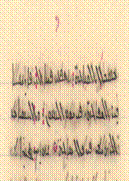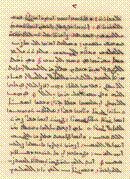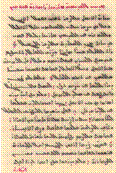A FIRST READING OF THE NEWLY DISCOVERED ODE
TO SAINT MARINA, THE MONK
By Guita G. Hourani
Chairperson of MARI
This third article on Saint Marina the Monk deals with the author's discovery of an ode in honor of the Saint written in Garshuni (Arabic written in Syriac script). The first article or Part I narrated the Saint’s biography according to the Maronite tradition, gave an overview of the most important references to her, related the legends surrounding her relics, and described her Sacred Office (the daily schedule of prayers). The second article or Part II focused on Saint Marina’s churches, sanctuaries, those especially devoted to her, and her iconography in Lebanon and Cyprus. The author thanks Mr. Moses Karkanny for his assistance in transliterating the ode from Garshuni into Arabic.
I. HOW THE ODE WAS DISCOVERED
The ode in Garshuni to Saint Marina is published here for the first time. It is a newly discovered manuscript, found by the author in the summer of 1999. The author was visiting Our Lady of Qannoubin Monastery for a day of recollection with the Antonine nuns who are currently the caretakers of the Monastery. Leafing through a Bible written in Garshuni before she went to sleep, she found the almost unrecognized two-page leaflet tucked among the thick pages.
Early the next day, she headed back to Beirut for a morning meeting. Despite uncertainties about the manuscript she was carrying, she felt that finding the ode while she was writing the biography of the Saint was Divine Providence, and not coincidence.
II. THE MANUSCRIPT
The Monastery of Our Lady of Qannoubin[i]and the grotto which still carries the name of Marina were the setting for the passion and sainthood of this maiden. [ii] This ode in homage to Marina gives a brief account of her life.
The ode is cursive, having been written with black and red Chinese ink and using an old-fashioned feather quill and ink well. The ode is written in the Estrangelo Syriac calligraphy. It is written on an ecru double sheet of lined paper 4.3 inches wide and 6.7 inches long. Each page has 19 lines on which the poet wrote his composition. The penmanship is superb. The manuscript is in a very good condition and has not been altered.
The first page begins with the title of the ode written in red ink and reads as follows: “Ode for Saint Marina the Woman Monk of Qannoubin.” Following the title are 18 lines of verse written in black ink with red punctuation. The last verse on this page is “They did not know at all that she is a virgin”. The first page ends with the first word from the second page, pursuant to the Syriac tradition in writing; however the word is written in Arabic instead of Garshuni.
The second page is kept blank. The third page contains the succeeding verses and is numbered in Arabic. Similarly, the poet used the 19 lines of the page to write his poetry but did not include the first word of the fourth page at the end of the verses. The last sentence on this page reads: “And was a living example for those who seek to embark…”
The fourth and last page has only three verses and ends with the words: “Intercede with the best of intercessions to our Savior for us on the day of our death, and in every hour of Judgment Day.” The poet closes the ode by offering it to Saint Marina, saying: “We offer you this in glory”.
Although the ode is written as prose, it is actually a poem of 10 strophes. Each strophe is composed of two verses and ends with two successive black periods and two superimposed red dots. Each verse is written in two hemistiches. Each four hemistiches have the same rhyme. Every hemistich ends with two periods, one in black ink and one in red. Each verse ends with three superimposed periods, one in black in the middle and two in red above and blow.
The language of the poem is mostly literary Arabic mixed with some colloquial Lebanese Arabic. The poet suppresses the accent-vowels to maintain the rhyme and the measure of the verse just as occurs in poems in the vernacular of all countries.
The main discrepancy in the narrative, as told by the poet of this ode, is that Marina went to Qannoubin because she did not find a women’s convent to join. Most accounts assert that she actually wanted to be with her father; hence, she had to disguise herself as a man to enter the monastery.
The manuscript may date from the 1800s or early 1900s because Garshuni was no longer used after that and the Monastery of Qannoubin -- where the manuscript was found -- was abandoned for the newly built summer Patriarchal residence of Our Lady of Diman in 1823.
III. THE POET OF THE ODE
The poet did not autograph the poem. Nevertheless, the ode gives clues which could be helpful in identifying the poet. The beautiful, steady handwritten Syriac script shows the poet’s fine grasp of Syriac calligraphy and style. He must have been an educated clergyman, possibly a scribe. When the Monastery of Qannoubin was the Patriarchal See, it was vibrant with the presence of so many clergy and prelates.
Because the word “patience” appears more than eight times and because of the repeated praise of monastic life, one may make some assumptions. Perhaps, the poet of the Ode to Saint Marina was a monk or a hermit who composed it and placed it in the Bible which he used each day when celebrating the Liturgy.
IV. THE TRANSLATION OF THE MANUSCRIPT
Some of the punctuation used in the manuscript can not be duplicated. Instead, each strophe is numbered and ends with similar punctuation to facilitate the comparison between the manuscript and (between) the translation and the development of the poet’s composition.
Ode to Saint Marina, the Woman Monk of Qannoubin
1.The life of man in patience is gained as the Bible says.
And everyone who is patient until the end is given the crown.
Hence we see in Saint Marina a proof.
She has gained the glory of joy through grace-filled patience*
2.She saw the world as a heaving sea of punishment,
With the seafarers shipwrecked, overcome by evil consequences.
And that the monastic life[iii] is the safe port and the achiever of hopes.
Her spirit became captivated with love for the life of a hermit to calm the mind*
3.When she did not find a convent for women to live chastely within its cloister,
She dressed as a man and joined the monks.
No one of the human race knew about her.
Except her father who accepted her in the monastery where he was*
4.He was guiding her to the way of perfection day and night,
Until she became a shining example among the righteous.
Prayers became her heart’s companions so she surpassed the quality of the elites
She became enchanted with fasting and concealed her abstinence*
5.Hell’s notables roused the people against her for immorality,
Who with the arrows of disgrace thrown at her purity and the marring of purity.
They did not know at all that she is a virgin.
They knew that they had discovered a candle lit above the lighthouse*[iv]
6.They brought her a baby remarking that he was born through disgrace.
She sustained these accusations with the patience of Joseph Jacob [Job].
She appealed her case to the Judge of Hearts and to He Who Knows the Invisible.
She did not speak that which would exonerate her from the stigma of guilt*
7.She raised the baby for two years with noblest patience,
While she was a target of the arrows of reproach and gossip.
But the Merciful One willed to alleviate this shame and to defeat these deceits.
He called her to Him and in her death was the evidence of her righteousness*
8.The monks were astonished when they knew that she was a maiden.
They wept in regret, they were amazed, and were bewildered [but] with pride.
For she, the one they thought to be clearly and publicly a man,
Was revealed a virgin who was patient in order to win the reward*
9.She disguised herself and accepted the bitterest of insults.
She applied the teachings of Christ with incredible patience.
Be patient and you will be saved, carry My cross it is very comforting.
Blessed are you if you were rebuked with vile words*
10.You meek [Marina], you brightly shined as the model of humility.
And you were a living example for those who seek to embark on the road of contentment.
Intercede, by the best of intercessions, for us with our Savior on the day of our death,
And during every hour of the Judgment Day*
We offer you this in glory.
V. CONCLUSION
Carbon dating of the paper and other thorough analyses are needed to date the manuscript and learn more about it and its poet.
The author of this article believes that this manuscript and other similar discoveries are part of the collective heritage. She decided, now that the ode has been made public, to send the original manuscript to the Maronite Patriarchal Archive in Bkerke where it will be safe and made available to other researchers.
[i]The Monastery was the Patriarchal See from 1445 to 1823.
[ii] Marina was disguised as a man in order to join her father in the monastery. She was later accused of fathering a child. She did not defend herself from the crime she was accused of, but with humility accepted the severe punishment that was pronounced against her by the Abbot: to leave the monastery and to raise the child. She spent the rest of her life living ascetically and looking after the child. Her identity as a woman was only revealed after her death. Léon Clugnet states that the confusion pertaining to all of the other saints named Marina is due to the translators and the copyists' attribution of the saint's origins to their own countries or other countries that they felt better fit the Saint's life. This is why we find that the Greek version of Saint Marina's life places her birth in Bethany; the Coptic version in Egypt and some of the Latin places it in Italy (Clugnet 1904: 265 footnote # 2). According to the most ancient accounts on Saint Marina the Monk, only one place of origin could be hers -- Lebanon. Clugnet resolves that until new discoveries are made, the only origin of Saint Marina must be the one known to us according to tradition and since the only tradition about this Saint is found among the Maronites of Lebanon, then Lebanon is to be considered the land of her birth (Clugnet 1904: 565). The Maronites resolutely believe that Marina originated in Lebanon and that as a monk she has lived and died in the Monastery of Qannoubin in the Holy Valley of Qadisha. J. Fiey in turn concludes that Marina in question is truly a local saint of Lebanon, victim of imposture (Fiey 1978: 33).
For the complete hagiography of the Saint see http://www.maroniteinstitute.org/JMS/january00/Saint_Marina_the_Monk.htm] and for information about her iconography, relics, and churches see [http://www.maroniteinstitute.org/JMS/july00/Saint_Marina_The_Monk.htm]
[iii] The author uses the word “Rahbaneh” in Arabic which means monastic order.
[iv]The lighthouse is the Monastery of Qannoubin which was known as a place of piety and reverence.


